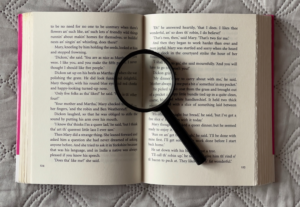
“It is the glory of God to conceal things, but the glory of kings is to search things out.” – Proverbs 25:2
“Attempt the end, and never stand to doubt. Nothing’s so hard but search will find it out.” — Robert Herrick
* * *
Since all human beings (not just kings) love to figure things out, I thought the Kill Zone Blog might be a good place to examine the history of the sleuthing mystery genre. A look back in time may even give us clues to facilitate our own successes. So grab your flashlights and let’s enter the dark and web-encrusted chambers of crime. The game’s afoot!
* * *
The format of a mystery novel is straightforward. The story usually begins with a crime being committed. It can be a murder, a suspicious death, a disappearance, even a theft. The rest of the story involves the search for the truth and ends with answers to the questions: who committed the crime, how, and why.
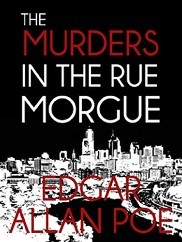 Edgar Allen Poe’s short story The Murders in the Rue Morgue (1841) is generally considered to be the first modern murder mystery, and its detective, Auguste C. Dupin, the first fictional detective. There was no monkey business in Dupin’s analysis of the horrific crime and identification of the murderer.
Edgar Allen Poe’s short story The Murders in the Rue Morgue (1841) is generally considered to be the first modern murder mystery, and its detective, Auguste C. Dupin, the first fictional detective. There was no monkey business in Dupin’s analysis of the horrific crime and identification of the murderer.
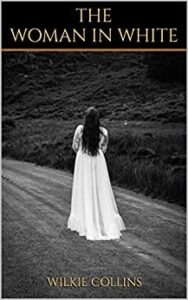 Wilkie Collins was a contemporary of Charles Dickens and is credited with the first novel-length mystery, The Woman in White (1859). The book doesn’t just stop at murder – it also touches on insanity, social stratification, false identity, and a few other themes. Collins considered the book his best work and instructed that the phrase “Author of The Woman in White” be inscribed on his tombstone. He also lays claim to the first detective novel, The Moonstone (1868).
Wilkie Collins was a contemporary of Charles Dickens and is credited with the first novel-length mystery, The Woman in White (1859). The book doesn’t just stop at murder – it also touches on insanity, social stratification, false identity, and a few other themes. Collins considered the book his best work and instructed that the phrase “Author of The Woman in White” be inscribed on his tombstone. He also lays claim to the first detective novel, The Moonstone (1868).
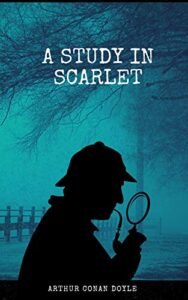 Arthur Conan Doyle published A Study in Scarlet, the first story featuring Sherlock Holmes and Dr. Watson, in 1887. In total, Doyle wrote 56 short stories and four novels featuring the famous detective. When he killed off Sherlock Holmes in The Final Problem (1893), the public outcry was so severe, Doyle had to bring him back in later works.
Arthur Conan Doyle published A Study in Scarlet, the first story featuring Sherlock Holmes and Dr. Watson, in 1887. In total, Doyle wrote 56 short stories and four novels featuring the famous detective. When he killed off Sherlock Holmes in The Final Problem (1893), the public outcry was so severe, Doyle had to bring him back in later works.
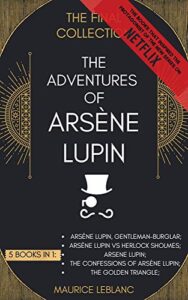 Maurice Leblanc began a mystery series in 1905 featuring the gentleman thief Arsene Lupin, a character who’s been described as a French version of Sherlock Holmes. In all, Leblanc wrote 17 novels and 39 novellas with Lupin as hero. Check out Joe Hartlaub’s excellent blog post about the books and recent TV series based on Leblanc’s hero.
Maurice Leblanc began a mystery series in 1905 featuring the gentleman thief Arsene Lupin, a character who’s been described as a French version of Sherlock Holmes. In all, Leblanc wrote 17 novels and 39 novellas with Lupin as hero. Check out Joe Hartlaub’s excellent blog post about the books and recent TV series based on Leblanc’s hero.
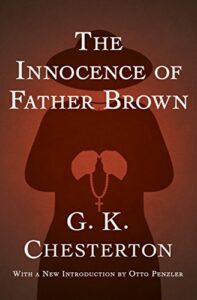 G.K. Chesterton is credited with creating the cozy mystery genre with a series of 53 short stories begun in 1910 featuring the Roman Catholic priest and amateur detective, Father Brown, who uses his intuitive understanding of human nature to solve crimes. The character was so popular, it inspired the Father Brown TV series that began in 2013.
G.K. Chesterton is credited with creating the cozy mystery genre with a series of 53 short stories begun in 1910 featuring the Roman Catholic priest and amateur detective, Father Brown, who uses his intuitive understanding of human nature to solve crimes. The character was so popular, it inspired the Father Brown TV series that began in 2013.
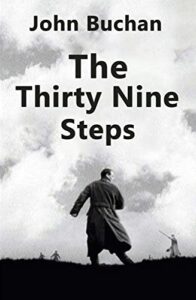 The Thirty-nine Steps (1915) by Scottish author John Buchan was the first of five novels featuring Richard Hannay. a man on the run who had been unjustly accused of murder. There are a couple of movie versions of The Thirty-nine Steps, but my favorite is the 1935 Hitchcock film starring Robert Donat.
The Thirty-nine Steps (1915) by Scottish author John Buchan was the first of five novels featuring Richard Hannay. a man on the run who had been unjustly accused of murder. There are a couple of movie versions of The Thirty-nine Steps, but my favorite is the 1935 Hitchcock film starring Robert Donat.
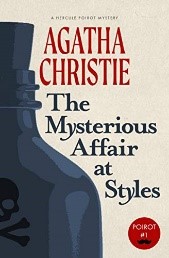 Cozy mysteries became very popular in the 1920’s and 30’s with several great British authors. Agatha Christie’s first novel The Mysterious Affair at Styles (1920), featured Hercule Poirot, a sleuth who used his “little gray cells” to solve mysteries. Poirot showed up in 33 novels and over 50 short stories. (I will have much more to say about Dame Agatha in a future post.)
Cozy mysteries became very popular in the 1920’s and 30’s with several great British authors. Agatha Christie’s first novel The Mysterious Affair at Styles (1920), featured Hercule Poirot, a sleuth who used his “little gray cells” to solve mysteries. Poirot showed up in 33 novels and over 50 short stories. (I will have much more to say about Dame Agatha in a future post.)
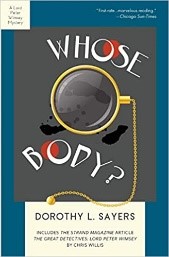
Dorothy Sayers introduced her own hero, the elegant but troubled Lord Peter Wimsey, in her 1923 novel Whose Body. Sayers wrote 11 novels in the Lord Peter Wimsey series.
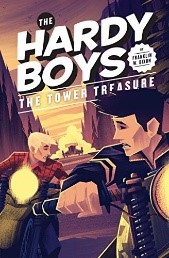
Younger readers joined the mystery caravan with the Hardy Boys series which began with The Tower Treasure in 1927. Several authors contributed under the collective pseudonym Franklin W. Dixon.
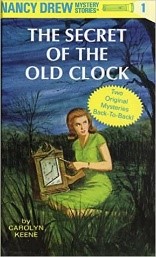
The Nancy Drew series entered the parade in 1930 with The Secret of the Old Clock. Again, several authors contributed under the collective pseudonym Carolyn Keene. Many of us credit the Nancy Drew books with our own interest in creating mystery stories.
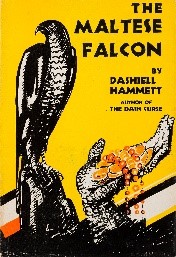 Hardboiled detective fiction became popular in the 1920’s and extended through the 20th century. Dashiel Hammett became famous for his character Sam Spade in The Maltese Falcon (1929). He also created the sophisticated couple Nick and Nora Charles in The Thin Man (1933). Strangely, Hammett wrote his final novel more than 25 years before his death. Why he stopped writing fiction is something of a mystery in itself.
Hardboiled detective fiction became popular in the 1920’s and extended through the 20th century. Dashiel Hammett became famous for his character Sam Spade in The Maltese Falcon (1929). He also created the sophisticated couple Nick and Nora Charles in The Thin Man (1933). Strangely, Hammett wrote his final novel more than 25 years before his death. Why he stopped writing fiction is something of a mystery in itself.
 Raymond Chandler was forty-four years old when he began his journey as an author. His first novel, The Big Sleep (1939), introduced the world to private detective Philip Marlowe. In addition to his short stories, Chandler wrote seven novels, all with Marlowe as the hero. His prose is widely admired and his use of similes is famous. Here’s an example from The Big Sleep: “The General spoke again, slowly, using his strength as carefully as an out-of-work showgirl uses her last good pair of stockings.”
Raymond Chandler was forty-four years old when he began his journey as an author. His first novel, The Big Sleep (1939), introduced the world to private detective Philip Marlowe. In addition to his short stories, Chandler wrote seven novels, all with Marlowe as the hero. His prose is widely admired and his use of similes is famous. Here’s an example from The Big Sleep: “The General spoke again, slowly, using his strength as carefully as an out-of-work showgirl uses her last good pair of stockings.”
So that completes this survey of the history of mystery. I selected these twelve examples from articles about the subject on various websites including biblio.com and wikipedia.com. Did you notice anything interesting about this list? Almost all of the wildly successful mysteries are series. Food for thought.
* * *
Back to our original question: Why do people love mysteries so much? Maybe it’s because a mystery novel is an example of mankind’s search for truth pared down to its most elementary format and delivered in a 6X9 inch package. The reader knows he/she will be satisfied at the end of the book with the answers of who, how, and why. And justice will be served. That’s a lot to accomplish in just a few hours of reading!
* * *
So TKZers: What is your favorite mystery novel? And who is your favorite mystery novelist? What books or authors would you add to my list?

Great rundown, Kay. Spot on. I think there’s a distinction to be made between “cozy” (or “puzzle”) mysteries, and the hard-boiled school (which was largely an American reaction to the British mystery form). Cozies are an implied contract between author and reader, that there will be a puzzle to be solved and the reader can guess as things go along…the author will try to “fool” the reader with a twist, but absolutely must play fair with the clues, etc. Most of the early cozies were in rustic settings.
The hard-boiled boys in America wanted to change the setting to the urban jungle, with its concomitant dangers and temptations, and focus less on the mystery than on the central character’s inner drive for justice. Chandler’s Marlowe is a knight walking the “mean streets.” But I’ll be danged if I can fully figure out the plot of The Big Sleep. Chandler didn’t care. Ambiguity is part of our experience…so there. (I’ve never fully been able to embrace that. My plots have to make sense and have to play fair.) Thus, these works are better designated “crime” or “detective” fiction.
My favorites of this genre:
1. The Maltese Falcon (Hammett)
2. Farewell, My Lovely (Chandler)
3. One Lonely Night (Spillane)
Good morning, Jim, and thank you for making that distinction.
I’m especially grateful that you mentioned Raymond Chandller’s plots. As much as I love the character of Philip Marlowe and as awed as I am by Chandler’s prose, I sometimes find myself at a loss in the plot. It’s such good story-telling, though, that I don’t care.
COZY: An amateur detective solves a murder with minimal blood and violence involved. It’s set in a small town with lots of eccentric characters and small town charm. Agatha Christie’s Miss Marple is an early example.
Wonderful post, Kay. Thanks for the history lesson. I certainly agree that all human beings love to figure things out, or in some cases, are tormented until they do.
I have to say that my favorite mystery books are The Hardy Boys series, since they were the first books to addict me to reading fiction. I read every one that our little town had in its library, and begged the librarian to buy those we didn’t have.
As for favorite mystery novelist, I would say Chandler, since I enjoy his prose, especially his descriptions.
Great post!
Good morning, Steve.
For sure, the Hardy Boys and Nancy Drew were huge influencers on many of us. I was surprised when I saw how early in the 20th century the publication dates were. They seem to be timeless stories.
Thanks for an excellent overview, Kay.
An author whose name escapes me said ALL stories, no matter what genre, have mystery elements that make the reader turn pages to find the answer.
Count another vote for Chandler, the “slumming angel” of prose.
Good morning, Debbie.
Good point about all books having mystery elements. If they don’t, they should.
Chandler is in a class by himself, isn’t he? I was surprised when I learned he was forty-four when he became a fiction writer (after losing his job as an executive of an oil company.)
Great post. The Hardy Boys were definitely my heaviest influence in the mystery genre. At first I didn’t know they existed and had started out reading Nancy Drew, but when I discovered the boys of Bayport, they became my staple read.
It is on my list to find and read some U.S. based historical mystery–glad to take suggestions if anyone has them. A lot of the historical mystery I come across seems to be confined to England.
This post also tied in nicely with yesterday’s post on the joy of writing. One of the key reasons I love to write, even though it doesn’t exclusively apply to mystery genre in fact, is that executing the details of a good plot for a novel is, to me, pretty much like solving a mystery. I’m brainstorming a historical series with some tricky plot issues, and the joy in writing that series will definitely be wading through communications, travel, political and social issues of the time to weave my series plot. When I get it all laid out, I’m going to feel like Frank & Joe after they’ve successfully concluded a case. 😎
Good morning, BK.
You make a great point! Plotting the mystery novel is a lot like solving a mystery. I come up with ideas (red herrings) that just don’t pan out, so I have to discard them and go on to something else. There’s a lot of sleuthing in this writing business.
Good luck with your historical series.
I’m having hard time, too, BK, thinking of US based historical mysteries–all the ones I can recall seem to be set in the UK, but I know there have to be some. Good luck with your historical series! I look forward to learning more about it when you’ve got it figured out.
As a teen, I remember watching Perry Mason. I continue to be impressed with Erle Stanley Gardiner’s writing ethic of 1.2 million words a year on a typewriter.
I also watched Perry Mason and loved the stories.
1.2 million words a year? That must be some kind of record.
Great intro to the mystery.
You pose a touch question. I’ll have to say Mickey Spillane’s I, The Jury is my favorite, with Chandler’s The Lady in The Lake a close second (with Sheriff Patton as my all-time favorite minor character!)
Mickey Spillane is another great one. When I decided to limit the list to twelve, I had to make some difficult choices.
Another vote for one of Chandler’s works! I also liked Lady in the Lake. I’ve never read Spillane’s I, The Jury, but I’ll add it to my TBR list.
Thanks for the suggestion!
Wonderful dive into the history of the mystery, Kay. I love literary history and your post is a great rundown of our beloved genre. I agree with Jim’s comments above, distinguishing between cozy and hard boiled and their different approaches. That said, I think both still adhere to the structure of mystery you laid out: problem, investigation, solution, which can be neatly divided into three acts, or, as I prefer, four acts, with the investigation being split into by JSB’s mirror moment when the sleuth learns that things aren’t as they original assumed, perhaps the second body has turned up. The sleuth is now proactive.
I see that pattern as paramount to the appeal of mystery (just as the structure of two people falling into love and the challenges before they can be together is at the heart of romance). We see that structure in “Murders in the Rue Morgue,” the first locked room mystery I can think of, and a personal favorite mystery short story.
I have a hard time picking a favorite mystery author–certainly for early mysteries, for me, it would be a toss-up between Christie and Doyle. However, Chandler and Hammett are two other favorites of mine. Sayers is also a fave.
I also have trouble picking a favorite book. Still, for this morning, I’ll go with Josephine Tey’s brilliant novel Daughter of Time, which features her detective Alan Grant laid up in hospital with a broken leg and being challenged to solve the mystery of the murder of the Princes in the Tower–was Richard the III guilty? –is a very compelling story.
Thanks for another engaging, enlightening, and fun post. Once again, my Monday is off to a good start.
Great comments, Dale. I like the idea of four acts with the mirror moment splitting the story.
Chandler is popping up on everyone’s list — he’s certainly on mine. Although I wouldn’t declare Agatha Christie to be my favorite mystery novelist, I’m on something of a mini-Christie binge this year, trying to discover the secrets of her monumental success.
I hadn’t heard of “The Daughter of Time” (love the title), but I just put it on hold at the library. Look forward to reading it. Thanks for the suggestion!
Have a great week.
Early man sees an animal chowing down on berries from a bush and walking away unharmed. He says, “Hmmm?”
Very bad things of a mystical and physical nature are going on in Thebes. King Oedipus starts an investigation. “Oedipus Rex” by Sophocles. Around 429 BC.
“Questions are at the heart of the mystic nature of humans. Note the role of questions in most religious observations. The Christian Catechism, for example.” –One of my novels.
The Five Ws of Journalism: Who, What, When, Where, and Why. And the one H: How.
Questions and mysteries are the nature of man. The mystery novel is one of the ways we formalize it.
Thanks for those observations, Marilynn. Life is indeed a mystery.
The Five Ws of Journalism: Who, What, When, Where, and Why. And the one H: How.
I’d add a sixth ‘W’: Wow!” Stack the ‘W’s so the big one is either first or last. In mysteries, the major ‘W’ usually comes last, as the final piece of the puzzle slides into place.
I enjoyed your article on the history of mystery novels, but you failed to include the Peter English, PI Mystery series by the 21st century author, Nick Nixon. 😉
Thanks for stopping by, Nick. Glad you enjoyed the article.
One has to leap over some pretty high hurdles to make this list. Keep at it!
Very interesting. Always enjoy a walk through history. Why not give us a post on where you believe the genre is going?
Thanks for stopping by, Ron. Very interesting idea — a blog post about current trends and future direction. I admit that’s beyond my capabilities, but there are some experts on this blog who might take the baton and run with it. Good suggestion!
Love this, Kay!
I’d have to say that Dame Agatha is my favorite mystery author, and Death on the Nile is my favorite of her prolific stories.
Good morning, Deb!
Dame Agatha is certainly one of the greats. I’m planning a blog post to focus just on the “Queen of Crime” and her incredible success.
Thanks for weighing in.
She’s perhaps THE grand master of the mystery in my book, Deb. I especially love her Poirot novels and stories.
I love puzzles, so mysteries have been a major part of my reading for many years. I read a lot of Maigret novellas by Georges Simenon that my mother found in the $1 bin somewhere, about 1965.
For some reason, I always associate mysteries with Clayton Rawson’s Death From a Top Hat. I suspect it may have been the first I read in that genre. Christie’s Ten Little Indians is also notable.
For TV series, the Poirot mysteries have been my favorites, though Midsomer Murders were also good, until they changed to a different “Inspector Barnaby.”
Poe is my favorite author for a lot more reasons than his role in development of the modern mystery, but I’d put him at the top.
I love noir and enjoy the outrageous similes thereof, like: “I plopped in a couple of sugar cubes and watched them melt away like hope and innocence dropped into a pool of decades.” –from Mike Sledge’s Christmas Carol
I also enjoyed Christie’s “Ten Little Indians”, aka “And Then There Were None.” The movie has a different ending than the book, and i admit I like the movie better. It’s close to the top for me.
Those similes! A world wrapped up in a clause.
Regarding Poe: I’ve been waiting for someone to appreciate my little joke about “There was no monkey business in Dupin’s analysis of the horrific crime and identification of the murderer.” 🙂 I can hear the groans all the way over here in Memphis.
Ah, but there was mönkey business! Poe was a genius and some of his works were prescient.
Yes, it was “And Then There Were None,” and the movie was the better version.
🙂
I have re-read Sherlock Holmes several times. Doyle was quite the story teller. I too think it is human nature to want to know how and why.
Aside from the authors who contribute here, I like Michael Kahn and Will Graham. Kahn’s books might be more procedural than mysteries but whodunit is always a good story. I miss Will Graham. He was starting a new series when cancer won out.
I read that Doyle wanted to end the Holmes series so he could concentrate on more serious writing, so he killed off his famous detective. But the public wouldn’t let him off the hook, so he had to bring Sherlock back. A victim of his own success.
There was also a “monetary incentive” to bring Holmes back. I liked Dr. Watson reading from his files for the stories.
I’ve actually read some of Doyle’s other works. They’re quite good. One of them is a historical novel, “The White Company.” Another is a picaresque novel, “The Adventures of Girard.”
https://classic-literature.co.uk/scottish-authors/arthur-conan-doyle/the-adventures-of-gerard/ebook-page-02.asp
Fooling the reader
I read one Margaret Truman novel. A murder in the Pentagon. Neat idea. Until the killer was introduced 4 pages from the end. FLAG ON THE PLAY. I finished the book next to a trash can where it fell right after I closed it.
It’s out of bounds to introduce the killer so close to the end. Shame on Margaret Truman.
Thanks so much for this wonderful, concise, and complete list of who’s who and what’s what in the mystery genre. I am bookmarking this to forward to anyone who might ask me where to start when they take that first deep dive into the pool that I’ve been swimming in for over six decades now.
Also…thanks so much for the shout-out. I’m humbled and gratified that you remembered. I’m still enjoying Lupin.
My favorite mystery is remains Presumed Innocent by Scott Turow. It is generally classified as a courtroom thriller but there is a mystery at its core that is not resolved until the final pages. I’ve read it once (at least) per year since it was published in 1987. The novel, besides being the basis for a 1990 movie, has been green-lit for a limited series for Apple TV.
As far as authors go, Raymond Chandler would have to be the one, both because of and in spite of his forgetting to resolve the issue of who killed the Sternwood chauffeur in The Big Sleep.
Thanks for the kind words, Joe. Your blog post about Leblanc’s stories, sent me scurrying off to Amazon where I got a collection. Although I haven’t read them all, I have watched all the available episodes of Lupin on Netflix. They are so well done!
Raymond Chandler seems to be at the top of everyone’s list. I do wish he’d written more than seven novels.
I love the Guido Brunetti novels set in Venice by Donna Leon and stories set in Canada by Louise Penny. Thank you for posting about Dorothy Sayers! A coworker introduced me to her books many years ago and I was hooked!
Thanks for your comments, Margaret. I’ve read several of the Louise Penny Inspector Gamache novels, and I love Dorothy Sayers. I’m not familiar with the Guido Brunetti series, though. I’m adding those to my TBR list!
Have a great week.
Great blog with wonderful food for thought. Thank you, Kay, for a concise history of the mystery genre.
Good evening, Beth, and thanks for stopping by.
It’s intriguing to me that so many of the great fictional sleuths were in a series. Writing a series in the mystery genre may be a smart idea.
Have a great week!